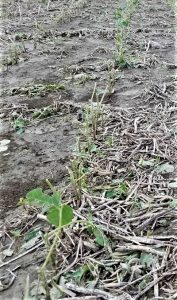Early Vegetative Soybean Defoliation
By Dr. Laura Lindsey, Adapted from C.O.R.N. 20-2021 and

Reports from surrounding states suggest defoliation or stem damage in soybeans are less critical to yield if they occur in vegetative stages, with stem damage being more critical to yield loss than defoliation (Shapiro et al. 2009). Even if some nodes on the stem were damaged or lost, soybeans can produce branches from the remaining nodes to help recover after hail events. Similar to corn, soybean defoliation and stem damage during reproductive stages will be more impactful on yield than during vegetative stages.
Recovery of fields should be assessed 4-5 days after the storm events at the earliest, and you should plan to contact your crop insurance agent if applicable regarding damage assessment.
A good resource to determine soybean yield loss due to hail damage can be found at: https://extension.unl.edu/statewide/saline/DLFE-10108.pdf.pdf
According to C. A. Shapiro, Extension Soils Specialist, T.A. Peterson, Research Technologist, Dept. of Agronomy, and A. D. Flowerday, Foyer Professor of Agronomy at the University of Nebraska, Yield loss predictions are based on two factors. Factor one is the stage of growth at the time of damage. Factor two is the degree of plant damage. Plant damage is classified as leaf defoliation, stand reduction, stem damage, and pod damage.
Accurate determination of stage of growth is necessary to determine yield loss due to hail. W. R. Fehr and C. E. Caviness developed one of the most widely accepted systems for describing soybean growth stages. Vegetative growth stages (or V-stages) are identified by the number of nodes above the cotyledons. A node is counted when the attached leaf is completely unfurled. Reproductive stages (R-stages) occur after the plant begins to flower and are defined by the development of the flowers, pods, and seeds. Determinate soybeans cease vegetative growth when flowering begins; indeterminate varieties continue to grow during reproductive stages.
Stand reduction is a measure of the number of plants killed by the storm. The pre-storm plant population is compared to the remaining stand 7 to 10 days after the storm to determine the yield loss due to stand reduction.
To determine the pre-storm population, count the original number of plants in 10 feet of row. Repeat this step several times throughout the field to get a representative sample. Now convert the average stand per 10 feet of row to plants per acre by taking (the average number of plants in 10′ row divided by the row spacing in inches) and multiplying that by 52,250 to determine the number of plants per acre. Using the same procedure, determine the remaining live plant population.
Original and final plant populations are used to estimate yield loss due to stand reduction.
For more details, refer to the charts at: https://extension.unl.edu/statewide/saline/DLFE-10108.pdf.pdf